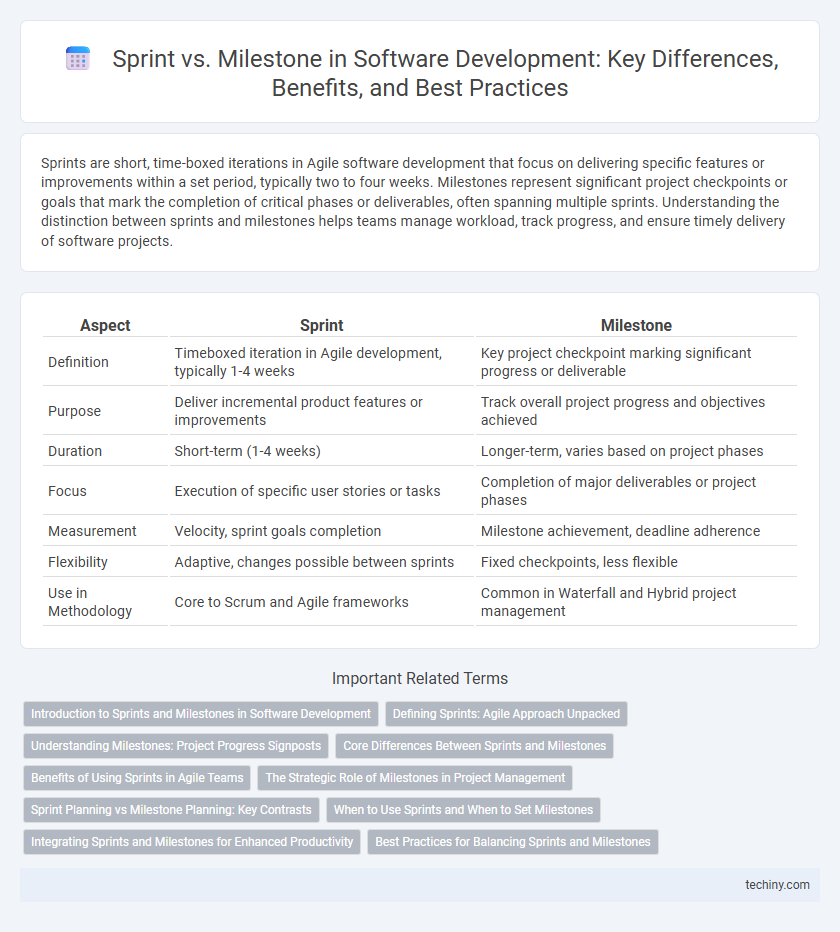Sprints are short, time-boxed iterations in Agile software development that focus on delivering specific features or improvements within a set period, typically two to four weeks. Milestones represent significant project checkpoints or goals that mark the completion of critical phases or deliverables, often spanning multiple sprints. Understanding the distinction between sprints and milestones helps teams manage workload, track progress, and ensure timely delivery of software projects.
Table of Comparison
| Aspect | Sprint | Milestone |
|---|---|---|
| Definition | Timeboxed iteration in Agile development, typically 1-4 weeks | Key project checkpoint marking significant progress or deliverable |
| Purpose | Deliver incremental product features or improvements | Track overall project progress and objectives achieved |
| Duration | Short-term (1-4 weeks) | Longer-term, varies based on project phases |
| Focus | Execution of specific user stories or tasks | Completion of major deliverables or project phases |
| Measurement | Velocity, sprint goals completion | Milestone achievement, deadline adherence |
| Flexibility | Adaptive, changes possible between sprints | Fixed checkpoints, less flexible |
| Use in Methodology | Core to Scrum and Agile frameworks | Common in Waterfall and Hybrid project management |
Introduction to Sprints and Milestones in Software Development
Sprints in software development are fixed-length cycles, usually lasting 1-4 weeks, designed to deliver incremental features through iterative progress in Agile methodologies. Milestones represent significant achievement points or deadlines within a project timeline, marking completion of major phases or deliverables in traditional or hybrid workflows. Understanding the distinction between sprints as ongoing development increments and milestones as key project checkpoints enhances planning and tracking efficiency in software projects.
Defining Sprints: Agile Approach Unpacked
Sprints are short, time-boxed periods typically lasting two to four weeks, during which Agile teams focus on completing a defined set of user stories or tasks from the product backlog. This iterative approach enables continuous delivery and rapid feedback, allowing teams to adapt quickly to changes and improve product quality. Unlike milestones, which mark significant project achievements or deadlines, sprints emphasize incremental progress and team collaboration to drive development efficiency.
Understanding Milestones: Project Progress Signposts
Milestones serve as critical markers in software development projects, indicating key progress points and ensuring alignment with deadlines and deliverables. Unlike sprints, which focus on iterative task completion within agile frameworks, milestones highlight significant achievements such as feature releases, phase completions, or critical approvals. Tracking milestones helps project managers measure actual progress against planned timelines, enabling timely adjustments and strategic decision-making.
Core Differences Between Sprints and Milestones
Sprints are short, time-boxed intervals typically lasting 1-4 weeks, designed to deliver incremental product features through iterative development cycles. Milestones represent significant project checkpoints or key deliverables that mark the completion of major phases or goals within the software development lifecycle. While sprints emphasize continuous progress and adaptability within Agile frameworks, milestones provide fixed targets for tracking overall project status and aligning stakeholder expectations.
Benefits of Using Sprints in Agile Teams
Sprints enable Agile teams to deliver work in short, manageable cycles, enhancing flexibility and allowing for rapid adjustments based on stakeholder feedback. This iterative approach increases productivity by focusing on prioritized tasks, fostering continuous improvement and early detection of issues. Frequent sprint reviews promote transparency and collaboration, ensuring alignment with project goals and improving overall quality.
The Strategic Role of Milestones in Project Management
Milestones serve as critical checkpoints in software development projects, marking significant progress points that facilitate strategic planning and resource allocation. Unlike sprints, which focus on short-term iterative development cycles, milestones provide a broader overview of project phases, ensuring alignment with long-term goals and deliverables. Effective milestone management enhances risk mitigation, stakeholder communication, and overall project visibility, driving successful project outcomes.
Sprint Planning vs Milestone Planning: Key Contrasts
Sprint planning centers on defining specific tasks and user stories to be completed within a short, time-boxed iteration, typically 1-4 weeks, to ensure focused agile delivery. Milestone planning involves setting broader project goals and deadlines that mark significant stages or deliverables, guiding long-term project progression and stakeholder alignment. Sprint planning emphasizes tactical, team-level coordination, while milestone planning focuses on strategic, project-wide objectives and timeline management.
When to Use Sprints and When to Set Milestones
Sprints are ideal for iterative development cycles, where teams focus on delivering functional increments within fixed time frames, usually two to four weeks, facilitating continuous feedback and adaptation. Milestones are best utilized to mark significant project phases or achievements, such as completion of a key feature or release candidate, helping stakeholders track progress at a higher level. Use sprints during Agile software development to enhance flexibility and responsiveness, while setting milestones to ensure alignment with strategic goals and project deadlines.
Integrating Sprints and Milestones for Enhanced Productivity
Integrating sprints and milestones in software development creates a structured workflow where sprints focus on iterative task completion while milestones mark significant project achievements. This combination enhances productivity by ensuring continuous progress tracking and aligning development efforts with strategic goals. Utilizing project management tools to synchronize sprint cycles with milestone deadlines optimizes resource allocation and fosters transparent communication across teams.
Best Practices for Balancing Sprints and Milestones
Effective project management in software development relies on balancing sprints and milestones to ensure timely delivery and quality output. Establish clear sprint goals aligned with milestone objectives, enabling teams to maintain focus and measure incremental progress while adapting to changes. Regularly review sprint outcomes against milestone deadlines to optimize resource allocation and enhance collaboration across cross-functional teams.
Sprint vs Milestone Infographic

 techiny.com
techiny.com